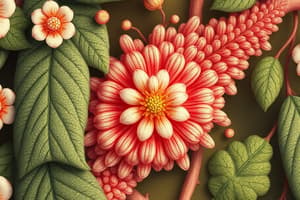Podcast
Questions and Answers
What are the two main organ systems of flowering plants?
What are the two main organ systems of flowering plants?
- Root and leaf systems
- Leaf and fruit systems
- Shoot and root systems (correct)
- Stem and flower systems
What type of tissue is meristematic tissue?
What type of tissue is meristematic tissue?
- Cells involved in photosynthesis only
- Cells arranged in complex structures
- Mature cells that have stopped dividing
- Immature cells that actively divide (correct)
Which of the following is a characteristic of meristematic tissue?
Which of the following is a characteristic of meristematic tissue?
- Cells are heavily vacuolated
- Cells are rich in lignin
- Cells lack intercellular spaces (correct)
- Cells have thick cell walls
Which meristematic tissue type contributes to the thickness of the plant?
Which meristematic tissue type contributes to the thickness of the plant?
Where is apical meristem located?
Where is apical meristem located?
Which type of permanent tissue protects the plant and regulates water loss?
Which type of permanent tissue protects the plant and regulates water loss?
Which of the following correctly describes intercalary meristem?
Which of the following correctly describes intercalary meristem?
What is the primary function of protoderm meristem?
What is the primary function of protoderm meristem?
Which statement about permanent tissue is true?
Which statement about permanent tissue is true?
What role do trichomes play in plant tissues?
What role do trichomes play in plant tissues?
Flashcards
Shoot System
Shoot System
Part of the plant above ground, including leaves, stems, flowers, and fruits, responsible for photosynthesis.
Root System
Root System
Underground part of the plant that absorbs water and minerals.
Meristematic Tissue
Meristematic Tissue
Immature plant cells that actively divide, responsible for plant growth.
Permanent Tissue
Permanent Tissue
Signup and view all the flashcards
Primary Meristems
Primary Meristems
Signup and view all the flashcards
Secondary Meristems
Secondary Meristems
Signup and view all the flashcards
Apical Meristem
Apical Meristem
Signup and view all the flashcards
Epidermis
Epidermis
Signup and view all the flashcards
Plant Tissues
Plant Tissues
Signup and view all the flashcards
Plant Tissue Types
Plant Tissue Types
Signup and view all the flashcards
Study Notes
Plant Body
- Flowering plants have two major organ systems: the shoot system (leaves, stems, flowers, fruits) and the root system (which absorbs water and minerals).
- The shoot system grows above ground, absorbing light for photosynthesis.
- The root system is typically underground.
Plant Tissues
- A tissue is a group of cells with similar structure and function.
- Plant tissues are categorized into two main types: meristematic and permanent.
Meristematic Tissue
- Immature cells that actively divide.
- Found in stem and root apices, leaf primordia, and vascular/cork cambium.
- Contribute to plant growth.
Meristematic Tissue Characteristics
- Composed of immature cells.
- Lacks intercellular spaces.
- Thin-walled cells.
- Rich in cytoplasm with small vacuoles.
Classification of Meristems
- Based on origin:
- Primary (derived from promeristem; found at stem and root apices).
- Secondary (develops from permanent tissues; adds thickness through secondary growth; examples include cork cambium and interfascicular cambium).
- Based on position:
- Apical (tips of roots and stems, for longitudinal growth).
- Intercalary (between permanent tissues, increasing internode length).
- Lateral (laterally on roots and stems, increasing thickness).
- Based on function (Protoderm, Procambium, and Ground Meristem).
Permanent Tissues
- Mature cells that have stopped dividing.
- Further classified into different types: epidermis, parenchyma, collenchyma, sclerenchyma, and vascular tissue.
Epidermis
- Outermost layer of plants; provides protection.
- Absorbs water and minerals in roots.
- Regulates water loss through transpiration in stems and leaves (via stomata).
- May contain trichomes (hair-like structures).
Parenchyma
- Thin-walled cells; various functions (photosynthesis, storage).
- Types include aerenchyma (air spaces) and chlorenchyma (chlorophyll).
Collenchyma
- Thick-walled cells with cellulose deposits.
- Provides primary support in herbaceous plants.
Sclerenchyma
- Dead cells with heavily thickened secondary walls containing lignin.
- Provides support.
- Types include fibers (elongated) and sclereids.
Vascular Tissue
- (Xylem and Phloem)
- Xylem transports water and minerals from roots.
- Phloem transports organic compounds from sites of photosynthesis.
- Xylem contains tracheids and vessel elements (tubular and elongated; dead at maturity).
- Phloem contains sieve tubes (alive at maturity) and companion cells.
Studying That Suits You
Use AI to generate personalized quizzes and flashcards to suit your learning preferences.




